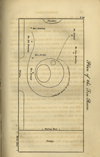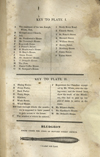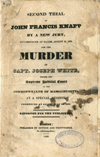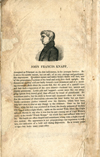



In 1816 Robert Donnall was charged with the murder of Elizabeth Downing. He was deeply in debt, and Mrs. Downing, his mother-in-law, had money which he stood to inherit. At trial, it was alleged that Downing had fallen ill after a poisoning incident, and Donnall, being a doctor, attended to her. A second incident led to her death. Donnall tried to have the body immediately buried. But instead the body was autopsied and Downing’s stomach-lining was found to be nearly dissolved by a corrosive agent. The autopsyists saved of the stomach contents in a bowl, which Donnall threw out. But another set of contents was saved and traces of arsenic found. Medical experts for the defense claimed that Downing could have died of cholera morbus or another gastrointestinal disease. The prosecution argued that such a death would take weeks, not hours. With the conflicting evidence, Robert Donnall was acquitted.
 The trial of Robert Sawle Donnall, surgeon and apothecary, late of Falmouth, in the county of Cornwall, for the wilful murder, by poison, of Mrs. Elizabeth Downing, widow, his mother-in-law, at the assize at Launceston, for the county aforesaid, on Monday, March 31, 1817. 179 pp. (Falmouth Lake, England, 1817).
The trial of Robert Sawle Donnall, surgeon and apothecary, late of Falmouth, in the county of Cornwall, for the wilful murder, by poison, of Mrs. Elizabeth Downing, widow, his mother-in-law, at the assize at Launceston, for the county aforesaid, on Monday, March 31, 1817. 179 pp. (Falmouth Lake, England, 1817).
NLM Unique ID: 28330850R See the LocatorPlus record

John Francis and Joseph Knapp hired Richard Crowninshield to murder their uncle Joseph White, a Salem, Massachusetts sea captain, in order to inherit some of his wealth. On an April night in 1830, Crowninshield entered White’s home and stabbed him to death, while the brothers remained outside, a few hundred yards away. A man arrested for pickpocketing stated that Crowninshield had confessed to him the murder of Captain White. Crowninshield denied any connection to the Knapps. However, another man, John Palmer, knew of the murder plot and sent the Knapps a blackmail note, which came to the attention of the authorities. Both brothers were arrested for murder, but before Crowninshield could testify against them, he hung himself in his cell. Under Massachusetts common law, accessories to a crime could not be convicted unless the murderer testified to their relation or if the accessories were immediately present at the murder. However, renowned lawyer Daniel Webster argued that the Knapps were near enough to the crime to have aided the murderer. The brothers were found guilty and hanged.


 Second trial of John Francis Knapp by a new jury: Recommenced at Salem, August 14, 1830, for the murder of Capt. Joseph White, before the Supreme Judicial Court of the Commonwealth of Massachusetts, at a special session, commenced at Salem, July 20, 1830… 28 pp. (Boston, 1830).
Second trial of John Francis Knapp by a new jury: Recommenced at Salem, August 14, 1830, for the murder of Capt. Joseph White, before the Supreme Judicial Court of the Commonwealth of Massachusetts, at a special session, commenced at Salem, July 20, 1830… 28 pp. (Boston, 1830).
NLM Unique ID: 101463057
See the LocatorPlus record

Last Reviewed: May 2, 2012



